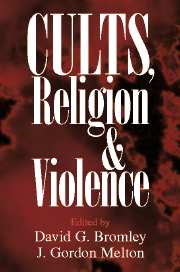Book contents
- Frontmatter
- Contents
- Acknowledgments
- Contributors
- Prologue
- 1 Violence and Religion in Perspective
- 2 Dramatic Denouements
- 3 Challenging Misconceptions about the New Religions–Violence Connection
- 4 Sources of Volatility in Religious Movements
- 5 Crises of Charismatic Legitimacy and Violent Behavior in New Religious Movements
- 6 Public Agency Involvement in Government–Religious Movement Confrontations
- 7 Watching for Violence: A Comparative Analysis of the Roles of Five Types of Cult-Watching Groups
- 8 Mass Suicide and the Branch Davidians
- 9 Occult Masters and the Temple of Doom: The Fiery End of the Solar Temple
- 10 Dramatic Confrontations: Aum Shinrikyô against the World
- 11 Making Sense of the Heaven's Gate Suicides
- 12 Lessons from the Past, Perspective for the Future
- Index
- References
4 - Sources of Volatility in Religious Movements
Published online by Cambridge University Press: 09 July 2009
- Frontmatter
- Contents
- Acknowledgments
- Contributors
- Prologue
- 1 Violence and Religion in Perspective
- 2 Dramatic Denouements
- 3 Challenging Misconceptions about the New Religions–Violence Connection
- 4 Sources of Volatility in Religious Movements
- 5 Crises of Charismatic Legitimacy and Violent Behavior in New Religious Movements
- 6 Public Agency Involvement in Government–Religious Movement Confrontations
- 7 Watching for Violence: A Comparative Analysis of the Roles of Five Types of Cult-Watching Groups
- 8 Mass Suicide and the Branch Davidians
- 9 Occult Masters and the Temple of Doom: The Fiery End of the Solar Temple
- 10 Dramatic Confrontations: Aum Shinrikyô against the World
- 11 Making Sense of the Heaven's Gate Suicides
- 12 Lessons from the Past, Perspective for the Future
- Index
- References
Summary
There are several factors operating with respect to novel, noninstitutionalized religious movements that tend to enhance volatility and the potential for violence. Some of these factors are fairly easy to enumerate (e.g., Robbins and Anthony 1995; Robbins and Palmer 1997; Dawson 1998: 128–157). However, such enumerations do not at this time allow us to predict which militant sects and esoteric cults will become involved in episodes of mass suicide, or mass murder, or in violent confrontations with authorities. Movements such as the Peoples Temple, the Branch Davidians, Aum Shinrikyô, Heaven's Gate, and the Order of the Solar Temple, which have become involved in sensational episodes of extreme violence, do tend to share certain characteristics. Unfortunately, many other movements that have heretofore been nonviolent also share many of these elements and even share some of the combinations of elements that have been identified in certifiably tumultuous groups.
The vast majority of unconventional and relatively noninstitutionalized “alternative religions” or “cults” are not explosively violent. The most that can probably be said at this time is that certain ideological, organizational, and tactical features of a movement such as apocalyptic worldviews, charismatic leadership, or a “totalistic” milieu (and particular variations on these features) may represent necessary but not sufficient conditions for the more spectacular kinds of violent altercations (Robbins and Anthony 1995; Dawson 1998).
- Type
- Chapter
- Information
- Cults, Religion, and Violence , pp. 57 - 79Publisher: Cambridge University PressPrint publication year: 2002
References
- 4
- Cited by



